I have a confession to make… I’m one of those weird people who reads the same book multiple times.
I can hear your gasps across the Internet. “But Noah, if you’ve read a book once, why start again?”
Look at it this way: Think about your favorite restaurant. (For me, that’s Tacodeli.) Chances are, you eat the same few meals again… and again… and again.
It’s not just restaurants:
- Songs. I’ve listened to Judah and the Lion’s “Take it All Back” on repeat nonstop
- Clothes. My wardrobe is the same Myles shorts and Sumo t-shirt (e’ry day)
- Coffee shops. Every morning, I get my free sample coffee from Trader Joe’s.
So why don’t we do this with books?
The first time I read The Ultimate Sales Machine by Chet Holmes, I was hooked.
I tore through the pages, marked up highlights everywhere, and couldn’t stop scribbling. Nearly every page of the book had a takeaway.
Over the years, I’ve read this book 3 times. EVERY TIME I learn new insights.
This book isn’t just about sales, it’s about kicking ass in business.
Chet Holmes was a sales master, but The Ultimate Sales Machine has changed the way I approach business in general.
Here’s what makes Chet special:
- Worked with over 60 of the Fortune 500 during his career
- America’s top marketing executive, trainer, strategic consultant and motivation expert
- While running nine divisions of a company for Charlie Munger (billionaire partner of Warren Buffett), Chet Holmes doubled the sales volume of each division.
Bottom-line: Chet knows how to create an insanely successful business.
To help you dive in and learn the goodies, I’m going to give you some golden nuggets from The Ultimate Sales Machine. These insights will help you improve your business.
You can listen to this episode on my podcast below. Or if reading’s your thing, keep on scrollin’.
Direct Download Link
Right-click and select ‘Save Link As…’
Subscribe in iTunes – Subscribe on Android – Subscribe on Stitcher
In this podcast and post you’ll learn:
- How to save 100 hours a year with one simple trick
- What my calendar looks like (and why it’s my #1 productivity tool)
- Why you should be paying to improve your productivity
- The incredible benefits of educating your customers — not over-selling to them
- Exactly why I took a bunch of OkDork readers to play ping-pong in New York
- How I use a list of dream podcast guests to inspire growth
- And much more.
Chet’s 14 essential business lessons
My biggest insights from The Ultimate Sales Machine can be broken down into three areas:
1. If you touch it, take action
2. Make a list
3. Block time in your calendar
4. Have an agenda
5. A company that thinks small, stays small
6. Build a process for massive growth
7. Make checklists for different parts of your business
8. Technology training is mandatory
9. Educate your customers, don’t sell them
10. Have a unique angle
11. Your dream 100
12. Rejection is going to happen
13. Become the hub
14. The killer closing question
Productivity Lessons from The Ultimate Sales Machine
1. If you touch it, take action
“I’ll just take a quick peek at this email…”
We’ve all opened emails and not replied, right?
It seems innocent enough — but 15 minutes per day for 365 days = 1 week OF YOUR LIFE. 😱
That’s one week of your life you’re wasting “just checking email.”
It’s not just email either. It’s true of checking our texts, browsing Instagram, or seeing if anyone has posted something new on Facebook.
“If you touch it, take action” is a mantra from Chet I try to live by every day.
To increase your productivity, work on your concentration. Think of it like a muscle: the more your practice, the stronger that muscle is going to get.
For example…
- When I open an email, I do my best to take action right there (or I try not to check my email until I’m ready to take action)
- I won’t start recording a new podcast unless I have time blocked out to get a run-through finished
2. Make a list
Reactive people don’t keep lists. Proactive people do.
At night, I take a note card and ask myself, What are the things I really want to do tomorrow? I put tomorrow’s date at the top of the card and make a checklist of everything I want to accomplish.
This helps alleviate anxiety, so when I wake up I don’t ask myself “What am I going to do today?”
Plus, it forces me to focus on the IMPORTANT tasks to move my business and personal life forward, instead of letting daily distractions take over.
Here’s a recent note card list:
- Call Mom
- Sell time capsule
- OkDork checklist (reviewing this article)
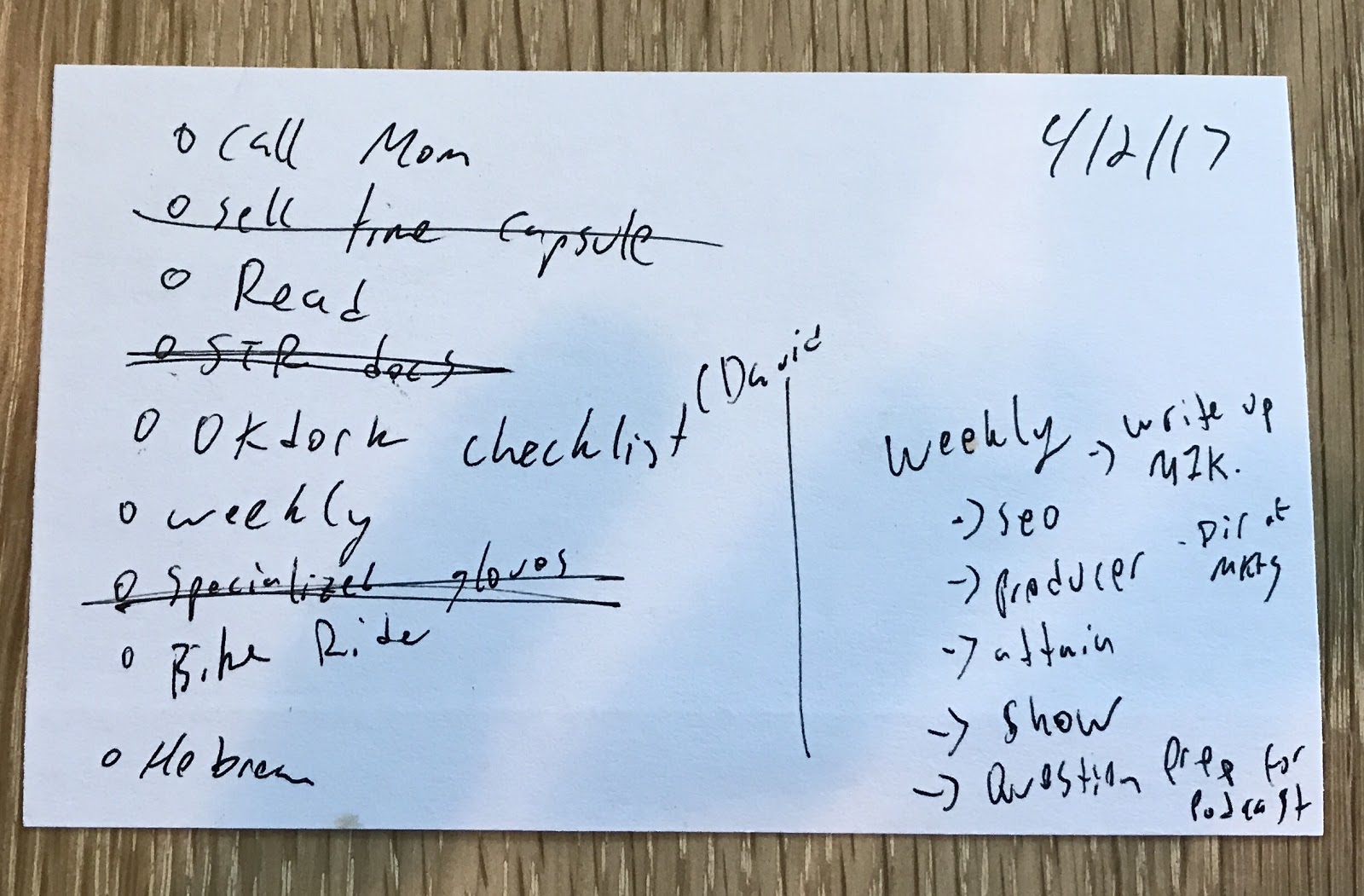
Don’t be reactive with your day. Be proactive and plan what you want to accomplish from the moment you wake up.
3. Block time in your calendar for important activities
Here’s a look at my calendar:
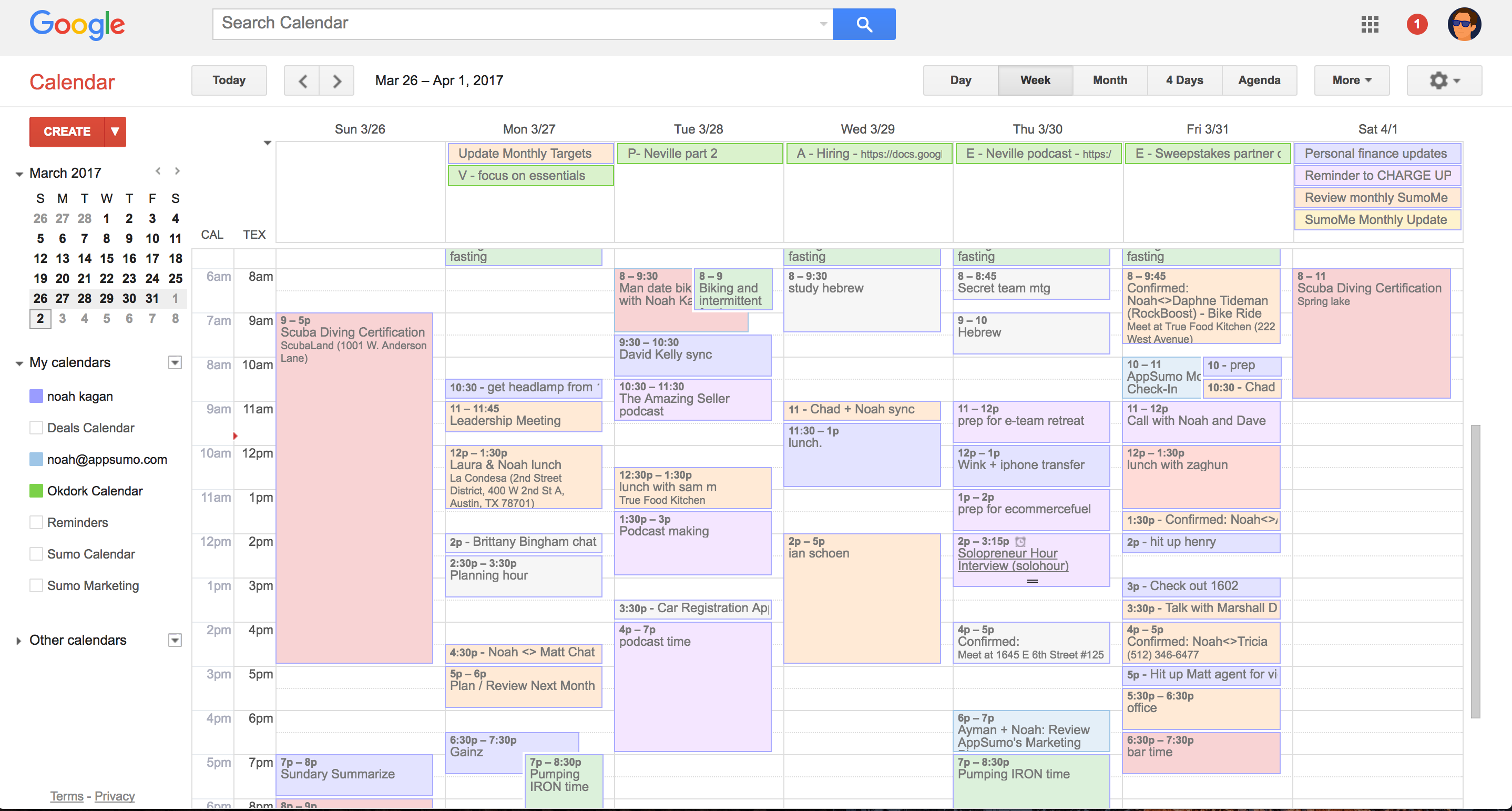
What do you notice?
I list everything in my calendar:
- Green (gym) – Workout sessions
- Grey (growth) – Reading and learning time
- Red (really fun) – Fun time with friends
- Pink (podcast) – Working on my podcast
- Salmon (Sumo) – Time for Sumo work
Calendars shouldn’t be only for meetings. Putting important personal events, goals, and other to-dos in your calendar makes you less likely to skip them.
For example, if my day gets super busy and I don’t have time blocked out for a Hebrew lesson I’ll skip it. I’m lazy by default.
But if it’s my calendar, I hold it to the same importance as a meeting with a colleague — and I’d think twice before backing out.
Here’s exactly how I decide what to put in my calendar:
- Create yearly goals (personal, health, and professional)
- Break yearly goals down into monthly goals
- Set weekly tasks to accomplish monthly goal
- Put time aside for these tasks in my calendar
Here’s example of my weekly to-do list that gets placed in my calendar:
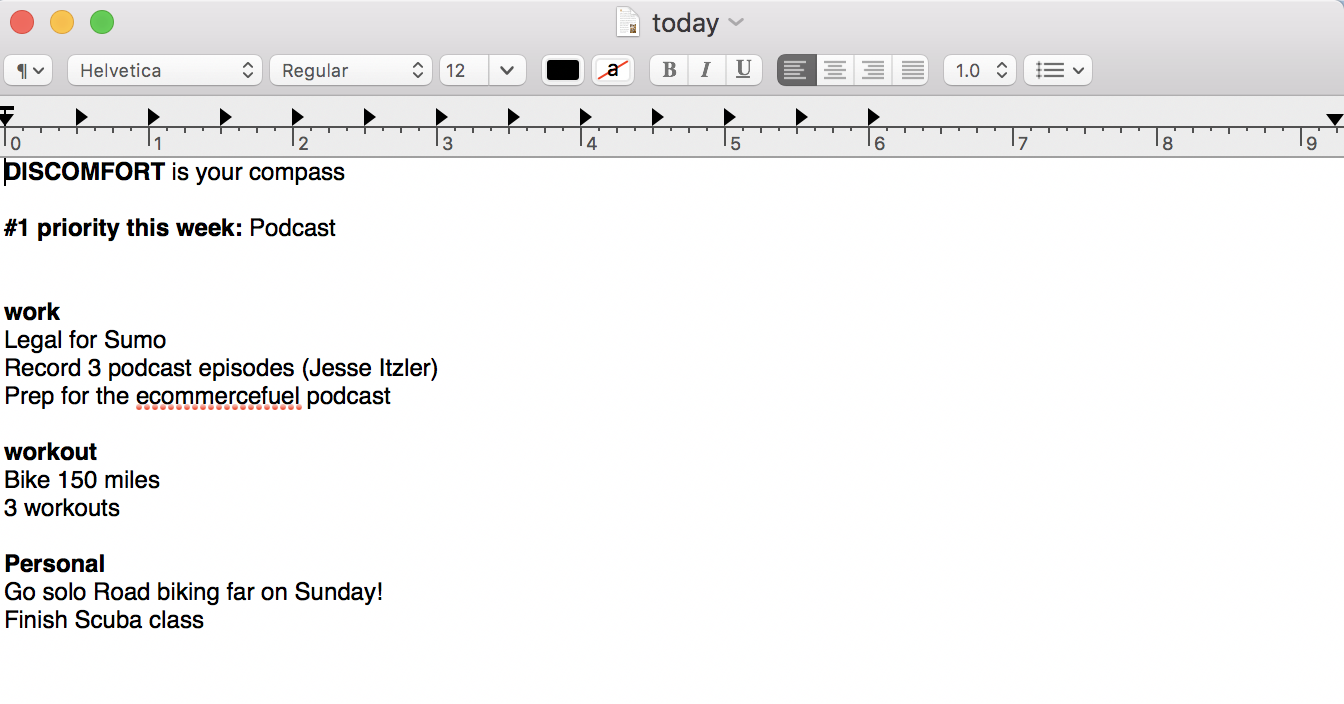
You can read more about my organization system here.
Like a skyscraper, your goals don’t just magically appear one day. It goes brick-by-brick, and you have to take a large-ass project, break it down into smaller chunks, and build towards the overall goal.
To make sure I’m on the right track, every Sunday I sit down and look at my previous week’s calendar and goal progress. I review how things went, and what I want to do next week to work towards my larger goals.
Pro tip: Work with an accountability partner to ensure you stay on track. Each week I send my review of the previous week, plus goals for the upcoming week, to my buddy Adam (the founder of My Body Tutor). He helps keep me accountable.
One of my professional goals this year is to get my podcast to 100,000 downloads per episode.

To push the goal along, one of my recent note card tasks was to be interviewed on another podcast. I blocked out an hour in my calendar to reach out to people about being on their show.
Think about what you want to achieve each week, break it down to smaller chunks, and block time in your calendar for each task.
4. Have an agenda for meetings
Junior High Noah would hate me so much for talking about “Agendas.” Keep rocking those Fubu jeans, young blood…
But Older Noah realizes agendas don’t have to be super corporate or bureaucratic. It’s about streamlining your conversations and wasting less or your time.
Agendas are useful in a business setting — and in a personal setting, too.
For example, about a week ago I went camping with my friend Ian. Together, we made a list of what’s on our mind and what we wanted to chat about. We ended up talking about babies, relationships, and asset allocation (#Jewlife!).
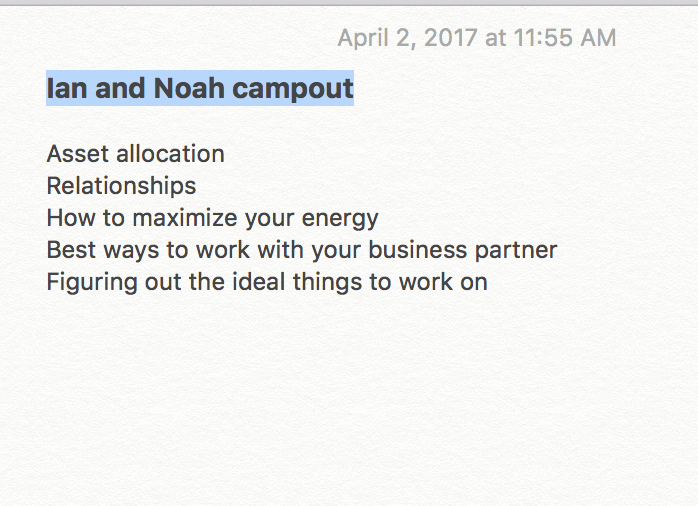
Our basic agenda made our conversations go much deeper, and our time together more rewarding.
How to 10x Your Business
5. A company that thinks small remains small
Are you thinking BIG? Like, Sumo-BIG?
$100,000 in yearly salary might seem big for some. Building a company with two employees might seem massive for others.
But here’s my challenge: HOW CAN YOU THINK EVEN BIGGER?
Instead of setting “small” goals, aim for the stars:
- How can I double my income this year?
- If I want to be worth $10 million in 5 years, what’s my first step?
- How can I go on TWO dream vacations this year?
It won’t happen overnight, but setting your sights on a big goal can help you eventually get there.
Here’s a great “think bigger” tactic Chet recommends in The Ultimate Sales Machine, which we implemented at Sumo:
“Get all of your employees and teammates together and ask them to give three examples of how to improve some aspect of your company.”
Have you ever been at a company and thought “this CEO sucks, I could run things better.”
Thanks to Chet’s book, we’ve implemented two ideas to think BIGGER help democratize growing Sumo.
CEO Anytime
First, we have a “CEO Anytime” Google Form where anyone on the team can submit thoughts and ideas on what our company should do. We just started this. One submission so far is “everyone should block out time for process improvements.”
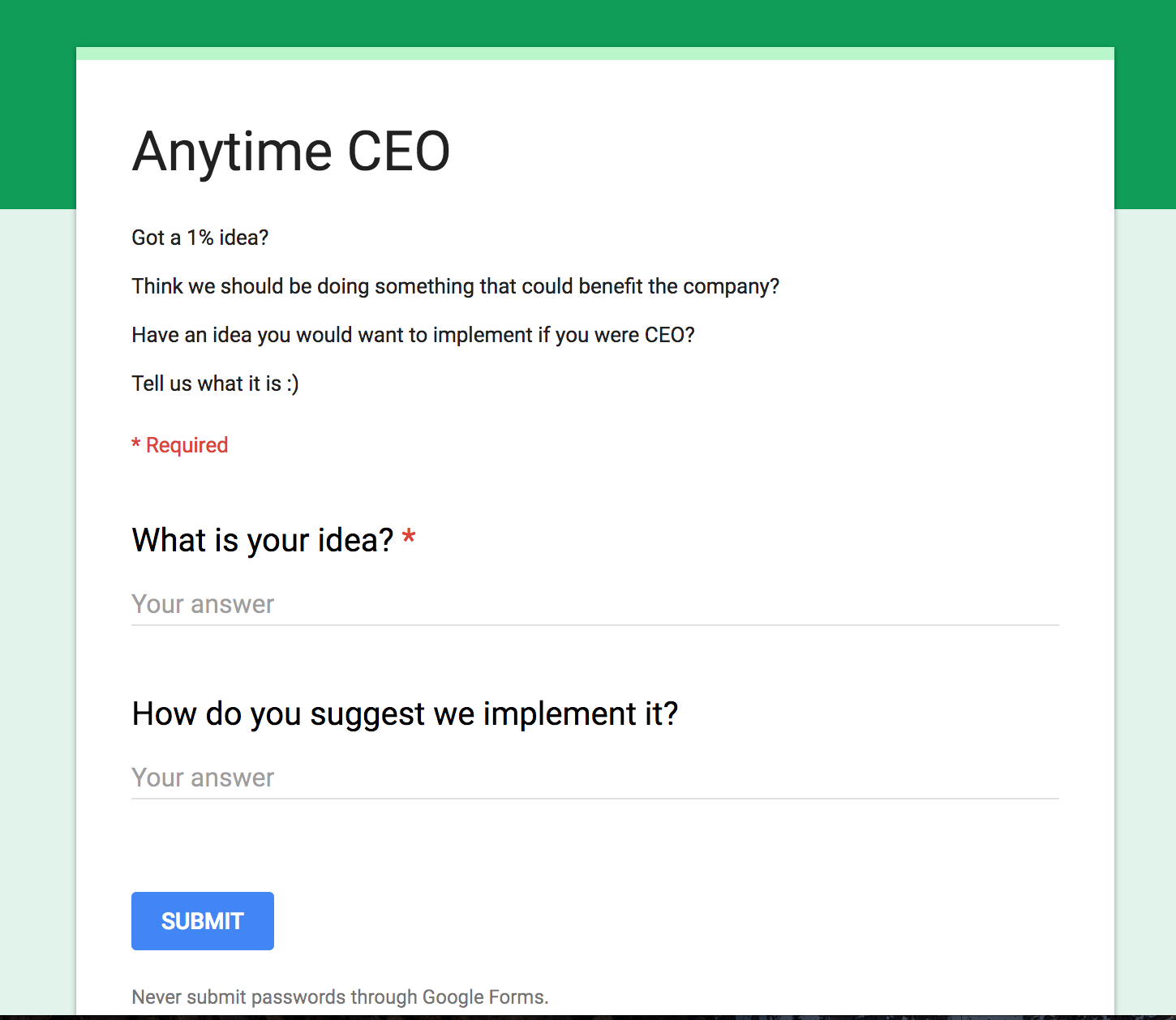
1% ideas
Second, in our weekly Sumo leadership meetings we have “1% ideas.”

Often times, companies think about the big goal — but forget the small steps involved.
“Let’s introduce a new product! Let’s spend money on a viral marketing campaign! Let’s pivot the business!”
This is a good start to thinking bigger… but what can you start doing today?
1% improvements each week can add up to huge changes over time. A few examples of how 1% ideas have helped us:
- We upgraded from Slack’s free version to Slack for Teams to help people search historical conversations, save time, and get work done quicker
- We streamlined our weekly meetings so ONLY team leads share updates (instead of everyone)
- We implemented a buddy system for new hires, so every new hire has someone to show them the ropes and help onboard them
These small improvements help us get towards our big revenue goals, like hitting 8-figures in revenue at Sumo last year.
6. Build a process for massive growth (like hiring 50 new people this week)
If you had to hire 50 people for your company this week, could you do it? What about every week?
One solution is to implement a Standard Operating Procedure (SOP). It might sound super fancy, but it can be as simple as a shared Google Doc with repeatable instructions
The goal with a standardized procedure (like a SOP) is to make behaviors repeatable as you grow.
At Sumo, we have a Sales Torah with every detail anyone could ever need about our sales process. It’s an easy way to ramp up a new sales hire quickly.

Our Sales Torah includes:
- Opening lines: How to kick-off the conversation with a warm lead
- Rebuttals: When someone first rejects, we have a response ready
- Demo examples: Case studies and examples of who’s using our service
It’s important to note your SOP should always be evolving. As things change, update the SOP.
Having procedures in place saves your energy. It frees your mind to focus on higher-leverage strategic activities.
7. Make checklists for different parts of your business
I nerd out over checklists. At Sumo and OkDork, they’re included in our SOPs.
For example, we have a checklist of the Noah Kagan Presents podcast. For every single episode, our checklist covers every task we need to complete. We know exactly what needs to be done, who needs to do it, and when it needs to be done by.
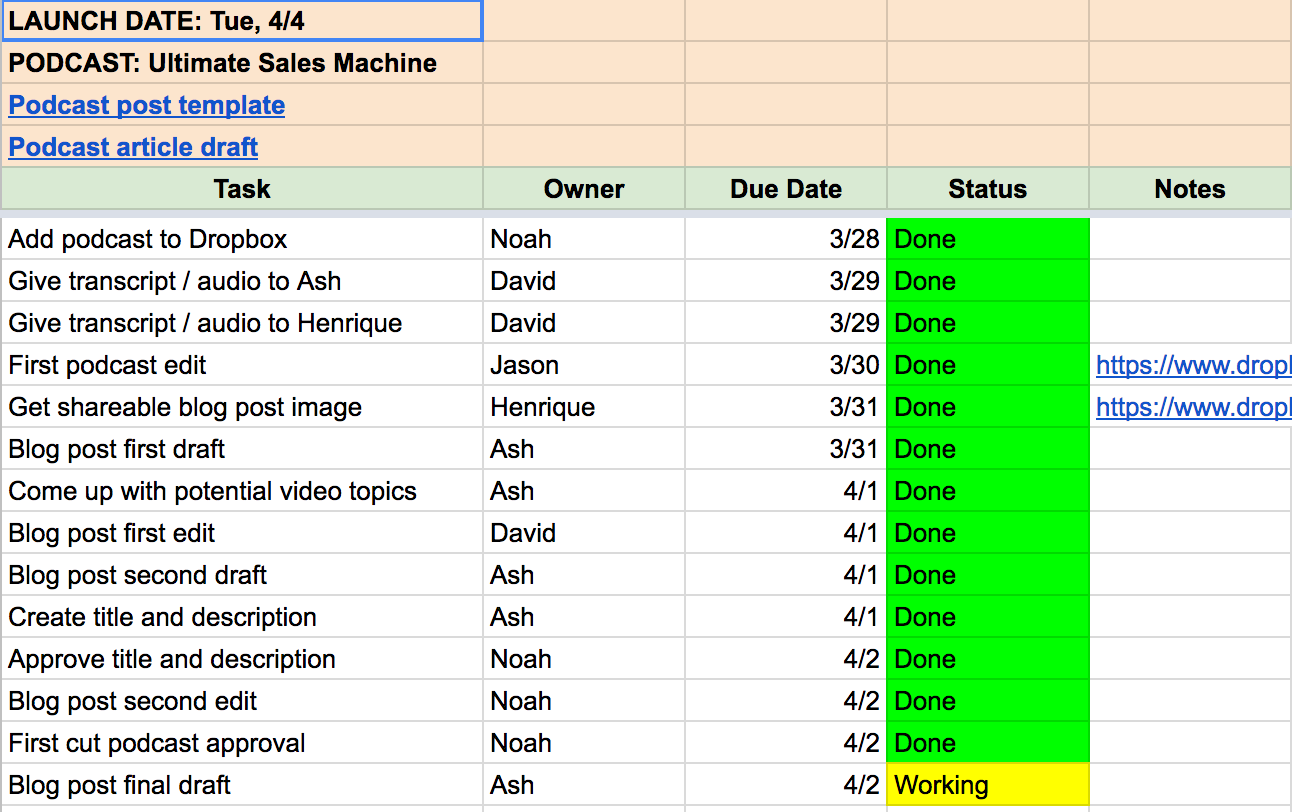
The checklist helps us push the podcast along quickly, and understand exactly what needs to be done.
Here’s what the current checklist covers:
- Making sure I upload the rough audio to Dropbox
- Writing the show description for Libysn, where we host the podcast
- Creating a blog post for the podcast (like this!)
- Adding the post to Buffer and Edgar social media tools
We constantly update our checklist based on what works.
If we discover a new tactic to help speed up the process, or make it easier for the time, we’ll add it to the checklist for next week.
8. Technology training is mandatory
Would you ever hire someone to stand over your shoulder and watch you type?
It might sound like a weird government conspiracy, but in The Ultimate Sales Machine Chet shares how he hired someone to watch him use a computer with the goal of increasing productivity.
Being watched while you use a computer might seem weird — but learning how you can boost productivity with the tools you use every day can be life-changing.
For instance, one thing I’m always trying to improve is my typing speed. If you’re using a computer all day and you type slow, all of your tasks slow, too.
I recommend using a tool called TypingBolt.com to find out how many words per minute you can type and improve your speed.
I type 145 words per minute. Can you beat me? Let me know in the comments below or tweet me @noahkagan.
Another tactic you can use to improve a skill is shadowing someone.
Right now, I want to learn more about Facebook Ads for my podcast and OkDork, so I pay someone to run my ads. Then, I observe how they do it and learn.
Sales Mastery
9. Educate your customers, don’t sell them
Do you realize you’re selling all the time?
Whether you’re asking someone on a date, trying to get buy-in for a work idea, or asking a friend for a favor, you’re selling.
Next time you’re selling, change your intention from wanting a “yes” to providing your prospect with so much value they say, “Wow, this discussion was amazing. I learned so much!”
Teaching someone isn’t about sales tricks, aggressive pushing, or “telling” someone to do something. It’s about getting someone to see their belief another way, and choose to believe the new belief or knowledge if it fits.
The best way that I’ve found to educate someone is through telling stories. And specifically a storytelling formula known as Before, After, Bridge. Here’s how it works:
- Before: Paint a picture of your prospect’s world where things are today
- After: Show how their world would be different after using your solution
- Bridge the two worlds together with your product / solution
A great example of Before, After, Bridge are before and after workout images.
Here’s how I looked before I worked out, and now after gaining about 40 lbs of muscle.
Imagine these pictures on a diet or supplement website. Add in a short story like:
“In high school, I was a skinny guy weighing 147 lbs. I told myself I would change… but years later, I looked the same. It wasn’t until I picked up Awesomemax Workout Get Jacked Formula Pro I was able to pack on 40 lbs of muscle.”
And suddenly, you’ve made a much more compelling argument.
Pictures plus a story shows the reader what to expect, and pushes them to imagine themselves getting the same incredible results.
10. Have a unique angle
To stand out against competitors you need to find an angle that makes your business unique.
For instance, let’s say you’re running a family lawn mower business called Sumo Mowers. One of your customers is thinking of shifting to a competitor. Here’s what you could say:
“Hey, you could go over to another provider, they might even be a little bit cheaper. But did you know that if one of their team gets injured on your property, you’re liable because they don’t have the correct insurance set up?”
You’re presenting the customer with a unique angle about your business — and the competition. In The Ultimate Sales Machine, Chet calls this, “a smoking gun against the competition.”
Find an angle which makes your product invaluable so your opponent can’t win.
Let’s say a customer comes to you talking about price.
Change the conversation to a point you know your company ALWAYS wins.
I call this “creating your home field advantage” or changing the playing field.
Here’s a real-life example. I used to run a Facebook games company called Gambit. Here are two unique angles I created to grow the company to $30 million in revenue in its first year:
- Showed how we were less expensive. On a piece of paper I would break down the costs of using Gambit compared to the costs of using a competitor. Our competitors had lots of overhead and bloated charging, so we’d always win this point.

- Used a visual example of our solution. For every customer, I’d create a quick drawing, chart, or mockup to show how easy it was to implement our solution. Here’s an example:
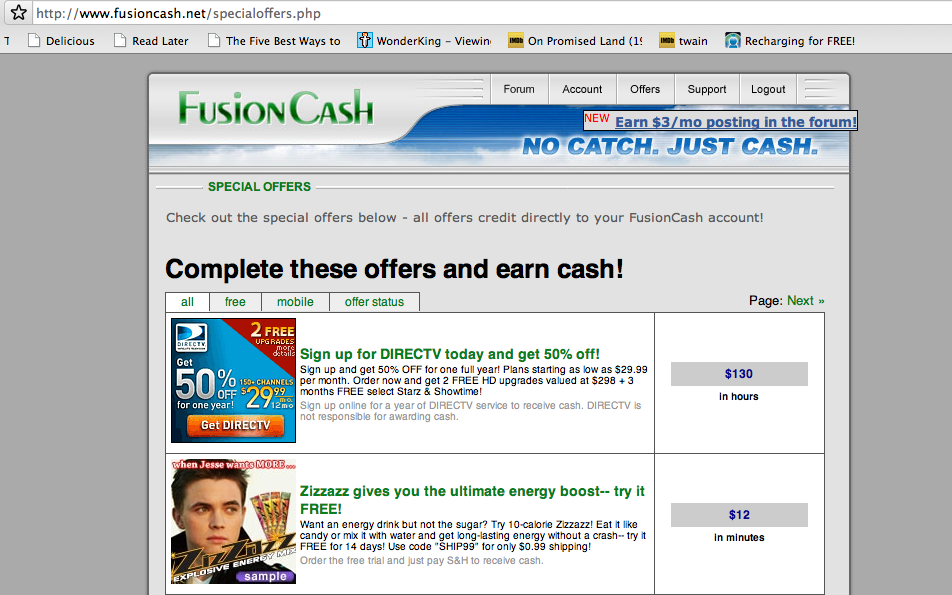
11. Your dream 100
People want to overcomplicate marketing. Here’s the most elegant way I’ve discovered to simplify marketing:
- Make a list of your target 100 customers
- Go out and try to get them
(If you want more ways, I made a YouTube on four questions to start any business.)
When it comes to marketing, most people turn to ads or PR right away and make general pitches without knowing exactly who they’re targeting.
To re-focus your efforts, ask yourself the question, “Who are 100 people I can hit up to sell this product?”
List as many target customers as possible. If 100 is too many for your right away, list 10. The key is to define, in exact detail, who you want to target.
Once you have your list, you can figure out how to reach them. It’s often easier than you think:
- Find their email
- Get a referral
- Reach out to them on social
I use this strategy myself.
For my podcast, I created a list called “The Attainables.” It’s a list of 100 people I want to feature on the show. With the list, I test different strategies to get ahold of people on the list each week.
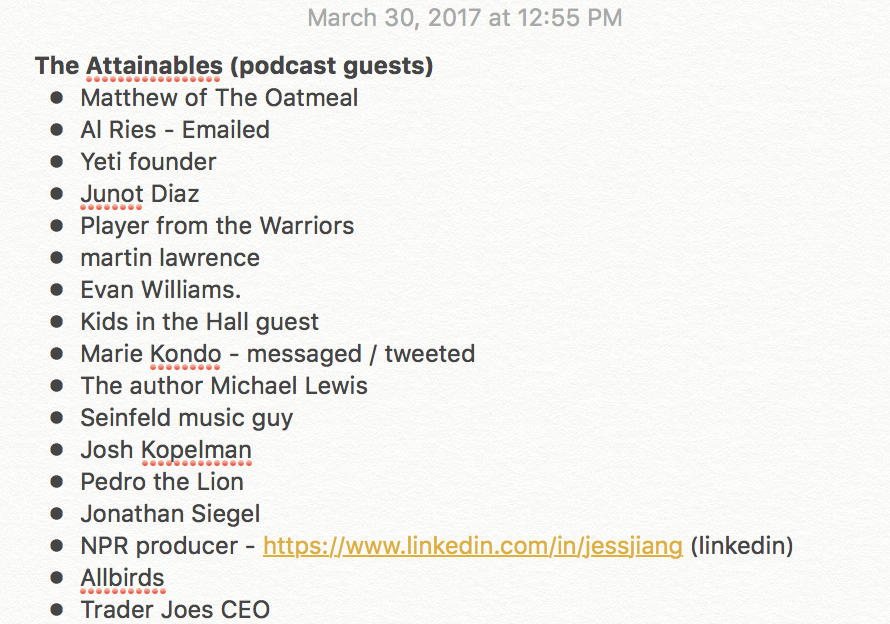
Once you have your dream list of 100 customers / clients / affiliates, go one-by-one each week and take steps to connect with them (block time in your calendar to do this).
12. Rejection is going to happen
Chet says it takes an average of 8 rejections to get a meeting. You need to build in procedures to follow-up with key customers and prospects so no-one slips through the cracks.
My friend Scott Britton shared a great quote with me recently: “Persistence beats resistance” (click to Tweet). To be great at sales, you have to embrace rejection and have a plan on how to deal with it every single day.
If you know each month you’ll have to follow-up with people, you can schedule the time so it happens.
There’s a bunch of software out there to help you with these tasks, too. If you’re emailing people, you could use the following tools to help automate the follow-up process:
At Sumo, we even leave all the applicants for our sales roles waiting for a reply to see who follows up. And when we were buying Sumo.com for $1.5 million, it took us over 200 emails and 7 years to get the deal done.
13. Become the hub
Your existing customers are your best salespeople. Create activities to connect yourself and your clients to each other.
A few months ago, I was heading to New York and I decided to host a meetup and play some ping-pong with OkDork readers and Sumo customers. The goal of this was to have some fun and connect with my readers and customers.

At the event, everyone I invited got free drinks, free ping-pong games, and the chance to connect with each other. Once the night was done, people told me they loved OkDork and Sumo even more now, and planned to share us with their friends.
Create opportunities to connect yourself and your clients to each other. Do something fun.
14. The killer closing question
“Any reason you wouldn’t make a purchase from us today?”
This my favorite killer closing question in sales. This information is invaluable. The beauty is you can then go away and solve that issue.
For instance, if someone says they won’t buy due to price, respond and ask what pricing they wanted. Maybe it’s a number they’re looking for, or maybe they’re just unsure of the value (and you need to re-explain).
You can also take the information and…
- Use it to improve your website or sales messaging
- Make changes to your pricing strategy for future prospects and customers (so you avoid hearing the same question)
- Focus your efforts on a specific type of “Ideal Customer,” so you can avoid freeloaders or bottom-feeders
____________________________
Today, I showed you some golden nuggets of business knowledge I took away from reading The Ultimate Sales Machine.
There were a few key themes I shared:
- You have to be proactive about productivity and train yourself to focus on the tasks that really matter
- Thinking big is the first step to 10x your business
- Sales is hard, but overcoming the fear of rejection is a huge stepping stone to success
These 14 lessons have changed aspects of my work life and helped me to grow Sumo to an eight-figure business. They could do the same for your business, too.
Challenge: Let me know your favorite takeaway from the podcast. I’ll buy 10 people copies of Chet’s book.

110 responses to “14 Business Lessons from America’s Greatest Sales and Marketing Executive”
Thank You for sharing an important post on “14 Business Lessons from America’s Greatest Sales and Marketing Executive.” Will share your writing with students taking Sales Training Courses
2 favorite take away
1) I love that you have on the list to call your mom ??
2). Put everything in your calendar. I do this also. Plus I’ll add things at the last minute so I can have a diary of what I worked on for that day
Love your emails
You’re learning Hebrew? Oy.
Also, please hit me up if you are in SD, would love to talk or hang out! If any other Noah fans want to hang out and just bounce ideas with each other please hit me up. I am here in Sioux Falls SD. Denver transplant.
Noah, please add a search function so I can find a specific episode I am listening to online please? Add a link in the podcast iTunes so I don’t have to search? Can you provide the templates that you are using in this article? If not would you let me sell templates I create based on the info above if not? I will be creating them anyway if you aren’t able to share.
So first, thanks for this book report. I need to go back and read Ultimate Sales Machine again (already read it 2.5 times) because it’s amazing and this guy is a genius, and it is super nice to have this outline (the time management chapters are kind of a snooze fest). Second, I tell people about this book all the time, and I used the landscaper workers comp story literally last week when mentoring a startup here in ATX. Third, thanks for being awesome. I discovered your podcast a few weeks before SXSW and I’m listening to every episode. I just wrote a review (which I never do) so yes it’s legit. I hope you keep going, or I’m going to have to figure out how to watch YouTube while I commute, which might not end great.
Am in the process of reading book and found your pod cast. I liked the format. I listened to it 2xs. Will down load and try to recreate your method for my educational business.
I sent through your 50% email stat to my team, and they are that little bit more motivated to follow up!
Noah! I’m about to start a software business and this podcast was like an eye-opener.
My key takeaways:
1. Making a list and blocking time for important activities. I think self-discipline comes before anything at all. And this sounds like the perfect hack in achieving so.
2. Thinking BIG! This is something I’ve believed in for a while now. And it’s the only reason that has led me to start up on my own. You just validated my belief.
Thanks, man. You’re such an inspiration!
Wow, that was a good one. I will definitely copy your quirk and listen to this episode again. Might read the book to. You rock!
Noah! This one is really great.
‘Is there any reasons you wouldn’t hire me today?’ I will test it and will let you know the reaction ?
Follow up, follow up, follow up
The “is there any reason you wouldn’t _____ today?” Is something I’ve heard before but never implemented. It’s something I am going to start using!
Btw Noah is there any reason you wouldn’t pick me for the book give away? ?
My fav takeaway is the closing question. It preemptively elicits what I could have done differently while I’m still engaged and still have an opportunity to address the issue. It’s like real-time feedback.
Second favorite is “persistence beats resistance.” Can’t hear that message enough and need the reframe to celebrate rejection. A recent win is recognizing a negative response as a considerable step above no response.
Become the hub. That really would be a good fit for what I do with dog training clients. They like being part of a community and I can see using this tip would strengthen those relationships.
Loving your podcast! It is very informative, fun and you have a great voice for it!
Pure gold, Noah. This episode is now on my ‘must listen to’ list for my friends. Thanks for sharing!
F*CK you Noah!!
I have just had to double back on my car journey, pull into a shitty side road to leave this comment after listerning to one of the BEST podcasts I’ve ever listened to!
Fucker
My biggest take away is the closing sales technique
Damn that’s good
Now I want tacos (but I’m in Middlesbrough, ??) and we don’t have tacos here.
(Note;l: business idea – c c c c challenge)
B) I’m now late to get home to the wife and kids, she’s going to have my balls, (not Ina good way!)
Send me a book, or I’ll just buy it on Kindle, whatever!
Love you
Mark
X
Just listened and the #1 thing was that you had a substantive business meeting with an agenda during a personal CAMPING TRIP ?. Love the idea of seamlessly integrating business and fun! I’d looooove to get the Sales Machine book!
My favourite parts are the closing question and the company who thinks small remains small.
I am following up all the emails I sent last month and didn’t got answered. Awesome article Noah, i am loving your content.
Takeaway –
I just listened this morning and I’m working on the dream 100 for my wife’s fashion design business right now. Hell yeah! Thanks Noah!
Shit, also just wrote my list for today, since I did not do so last night.
My takeaways:
Chet Holmes – Ultimate Sales Machine (This book has been on my Amazon ‘Wish List’ forever. Maybe since I heard it mentioned by Noah on Tim Ferriss?)
Give people an experience – drove with a blind woman.
What is something that my potential clients have always wanted to experience that I can give them?
How can I surprise and delight them?
1. Productivity
Micro tasks become macro time loss – If you touch it, take action
List for tomorrow – write at night
Block out time for important things ahead of time – use my G calendar on Sunday. Big goals become small tasks and then put it in calendar, mapping to end goal
Agenda for meetings – be early. 30 minute calls can be 10 minute calls w/ an agenda
2. 10X Your Business
If my goal is to keep it a side hustle, that’s all it’ll ever be – if I only had 6 months to accomplish my 1-year goal, what would I change?
How could I improve 1% each week? (70% improvement per year w/ compounding) – Time-saving apps and processes
Processes in place – Am I building this to scale up at all? SOPs – Make my own Torah – what do I need to make to get them to be able to do it in a one day (opening lines, rebuttals, checklists) – keep this updated over time
Tech training is mandatory – pay to improve the tools I use daily, type faster, shadow somebody while they work
3. Sales Mastery
Educate your customers, don’t sell them – get them to say “wow, i didn’t know that.” Educating them almost incepts them into thinking it for themselves.
Stories are perfect for this – like a diet commercial, show the struggle and then the after story
Unique angle (smoking gun) – find data or an angle that makes your product invaluable (home field advantage), if they talk about price, change the playing field to one you always win on.
Show how competitors are screwing over customers. Create a visual experience of how their success would look.
Dream 100 – make a list of your target 100 customers. Use Google sheet, who are the first 100 people I can hit up to buy this. Go through 1 by 1 each week.
Rejection – 8.4 rejections to get a meeting. Know it’s going to happen so you can plan for it. Schedule the follow up. Outreach.io yesware.com
Persistence beats resistance
Sumo rejects everybody in the final round just to see their follow up
Following up is everything in sales and LIFE.
Most responses come on the second email
Create activities to connect yourself with your clients – become the hub
Killer closing question – Any reason you wouldn’t make a purchase for us today?
Rye, surprisingly.
My favorite takeaway was the importance of following up.
Rejection is a crappy feeling.
And it’s not in our nature to go straight back to the source of rejection, which is why persisting is hard. But this is really one of the key things that separates successful people from unsuccessful people.
What up Noah, listening to the podcast. Biggest take away is from the Sales Mastery –
Educate your customers, don’t sell them. That’s powerful and I like it. (Honorable mention to the killer closing question) You actually did this to me via email back on 5/21/14 for the Headlines Tool Survey. Love it.
I listen a lot to podcasts, but never left a comment,
but you convinced me, it’s not because the gift, absolutely not
I just wanted to say: You do a great work here, you create a very helpful content
Keep going
Big Thanks
Best take away from this episode: Follow up, follow up, follow up.
These book report podcasts are by far my favourite to share with others. I read and recommend lots of books to friends and family, but for those who are honest about telling me they likely won’t read that book… having this podcast to point them to PLUS the detailed show notes is fantastic.
Thanks Noah!
Your tip on using a note card to write down the following day goals is PURE GOLD! Definitely going to incorporate that into my life.
The Ultimate Sales Machine has been on my to-read list for awhile now. Great review Noah!
My favorite takeaway was about the SOP. It’s something I’m implementing in my business with the checklists, and when I was listening some ideas to take action on came to my mind. The procedures are vital to businesses and I’ts great to learn how you implement it, as you have a successful business such as Sumo.
The biggest takeaway for me was the 1% improvement, such s small thing but with such big potential. Why aren’t we doing more of this?
Noah – loving the podcast. Don’t make me go to iTunes for a review – ok, I’ll do it.
I like these book reviews. I appreciate how you tie the advice to actions. Leading by example.
I also go back and read books. It has taken many of the authors years to learn and apply the concepts, so why would I get it reading it for the first time? Many things are easy to read, but hard to put into practice.
Purchasing the book.
Thanks.
I just wanted to leave a comment. Your podcast is my new favorite.
Hey Noah,
Great episode. My favorite takeaway was creating a SOP. I’m currently in the process of trying to productize the some of the finservMarketing offering so I can scale the business more efficiently. I really like this suggestion.
BTW: While I have you. You’ve mentioned working with a therapist on a few episodes. Can you share how you chose who you work with? Feel free to shoot me an email or PM if you are open to sharing who you work with here in Austin.
Hi Noah – My first podcast comment ever and I’m an avid podcast consumer. Listening on my way into work this morning. I’m going to implement the 1% improvement today in my weekly team meeting. My favorite aspect of this episode is the bit on “persistence”. While I’m not directly in sales, I do have a need to grow my piece of the business and have never really thought of it like this – need to schedule follow-up and monitor it to be sure I’m getting responses and feedback, not simply lobbing an email over the wall. 8.4 rejections before successfully scheduling a meeting – again, need to focus on being persistent. Thanks for the insight!!
Andy
By far my favorite part was the concept of taking yearly goals and translating those in to weekly tasks that you can review. I love thinking about and setting goals but I tend to be pretty bad at following through on them because they seem so abstract compared to where I am when I start.
The “How to 10X your business” section has me thinking pretty hard. I have a rough blueprint to significantly expand our grocery wholesale business in Puerto Rico from 1 location to 5. There are internal and external obstacles to executing this plan, but this section has pointed out a few gaps in my plan that I have to fill out, specifically with SOPs and training.
Thank you, great podcast. The one with Neville was really good too.
Noah, the podcast was great and the transcribed notes were very #9, 10, and 14 are big takeaways.
Thank you for putting this together.
Great episode! What wow:ed me the most was your 50% open rate on the first follow up e-mail.
But lots of other things to learn, even though I have already read The Ultimate Sales Machine – I guess it’s time for me to re-read it!
Noah, this was one of your greatest podcasts yet! Keep ’em coming 😉
My take away: Being persistent!
Noah – great podcast. I appreciate the cliff notes version of a fantastic book. Love the idea of re-reading a great book, like going back to a great restaurant. Would love to see more snippets from great Sales/marketing books and your unique spin. #JewLife
Yo hot pocket. Challah bread is definitely my favorite.
I remember when you recommended The Ultimate Sales Machine years ago and it made a huge impact in my life. I’ve read it 3 times since then. I lost the book with all my notes though….
The biggest takeaway for me was to have an agenda for meetings. By creating an agenda it improves efficiency and also adds constraints that improve people’s creativity.
P.S. Is there any reason I wouldn’t win a copy of the book? 😉
145 words a minute kagan, you are a mutant! 73wpm for me and I thought I was pretty good, time to raise my game
Loving Typingbolt. Your speed is 97 WPM which is Pro!
We have an SOP doc as well. Another benefit is it really helps to guide on calls and other internal processes. “Tribal” knowledge is a nightmare to use long term.
Biggest takeaway: I was an idiot for letting my bruised ego stop me from following up with Samantha from AppSumo on my application for a content writer.
Well, everyone else is probably going to say it, but the “is there any reason why you wouldn’t ….” is the supreme golden nugget I picked up because kittens are fluffy. Also, thank you for the increase your mouse speed tip in Tim’s book.
Hey Noah – great podcast, best takeaway from this episode was the importance of following up. I’m a bond salesman and work in very competitive and commoditized market, I recently almost gave up on a prospect after 9 months of multiple follow ups….finally in a last ditch effort I started to leave a voicemail after every email. This tactic lead to a big trade and was an example of standing out from the crowd of just emailing…the calls/vm’s got it done. Thanks!
Hell yea! Way to go Ryan.
Fantastic episode. Loved the solid reminder to embrace rejection and keep following up even when we don’t hear back right away. The killer question was also a really awesome take-away, even for someone who isn’t a salesperson. Earlier in the episode, Noah makes an excellent point about how we’re constantly trying to “sell” ourselves even outside of work. So true.
I’m curious, what are people’s thoughts on using the killer question when interviewing for admission into a competitive program (either academic or something like a highly-regarded trade school)? Would it be off-putting to ask “Is there any reason you wouldn’t let me into your program?” at the end of the interview?
You can phrase it anyway that is comfortable for yourself. The thing I like about this questions is it gives you a chance at addressing any hesitations the other person may have. The way you phrased it doesn’t seem rude and feels like it puts them on giving you some explanation.
Makes perfect sense. Thank you!
My favorite takeaway was definitely the amount of rejection it takes to get a meeting and that you need to keep following up. Persistence is key!
Thank you for this awesome episode! My Takeaway: anticipate and even celebrate rejection!